Kathleen Hooper offered a delightful surprise, securing four tickets to John Mayer’s concert at the Clark County Amphitheater in Vancouver, Washington, on July 17, 2013. This memorable evening included our family friend, Mollie Moore, joining us for dinner and the show. Despite Mayer’s ongoing recovery from throat surgery, his performance was nothing short of powerful and controlled.
 Kathleen Hooper & Mollie Moore
Kathleen Hooper & Mollie Moore
His vocal strength was evident; he navigated his songs without straining, perhaps adjusting keys to protect his vocal cords. To our ears, Mayer’s voice was deeply emotive, connected, and vibrantly alive. We were all captivated by his sheer musical talent and electrifying guitar solos. Simply put, he was phenomenal.
 John Mayer “Born & Raised” World Tour 2013
John Mayer “Born & Raised” World Tour 2013
For encores, John Mayer returned to the stage, delivering hits like Gravity. His professionalism and respect were palpable. He expressed sincere gratitude to the audience, acknowledging our enduring support. For Tracy and me, this concert felt particularly special, as we had regrettably missed his 2007 performance due to work demands. This time, experiencing him live was truly a blessing, a moment of reprieve and musical rejuvenation.
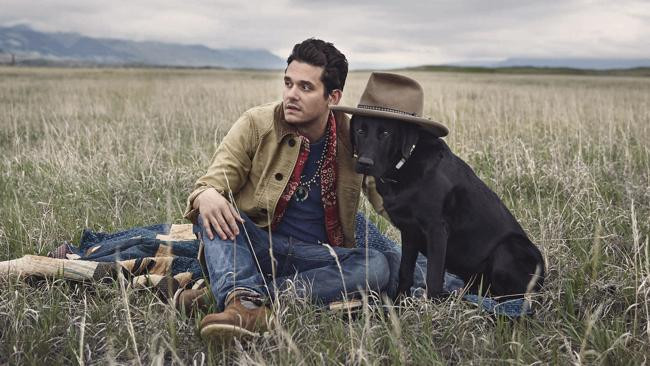 John Mayer concert stage backdrop with Southwestern landscapes
John Mayer concert stage backdrop with Southwestern landscapes
Mayer’s stage setup, while seemingly contemporary, hinted at a reverence for antiquity. The backdrop transformed the amphitheater into a panorama of the American Southwest, reminiscent of Arches National Park or Monument Valley. Mesas and buttes alternated with a mesmerizing light show of the Aurora Borealis, the Milky Way, and vivid sunsets. These iconic landscapes starkly contrast Mayer’s New England origins. His “Born and Raised World Tour” title took on deeper meaning, suggesting a spiritual upbringing rooted in diverse American landscapes, beyond his Connecticut birthplace.
 John Mayer in jeans, white t-shirt, bandanna, and squash blossom necklace
John Mayer in jeans, white t-shirt, bandanna, and squash blossom necklace
Earlier in the evening, Tracy had remarked on John Mayer’s striking appearance – jeans, a white tee, a blue bandanna, and a distinctive Squash Blossom necklace. While I sported my own black hat, her comment about Mayer’s style did give me pause.
 John Mayer wearing a squash blossom necklace onstage
John Mayer wearing a squash blossom necklace onstage
My initial thought: Aren’t Squash Blossom necklaces traditionally women’s jewelry?
Navajo women are frequently adorned with squash blossom necklaces, alongside silver bracelets, concho belts, and beads. These necklaces, symbols of fertility and rebirth, are often associated with feminine symbolism. I had even gifted Tracy an antique Squash Blossom necklace from Taos, New Mexico. However, reflecting further, men are equally integral to fertility and life’s renewal. Why should this powerful symbol be exclusive to women?
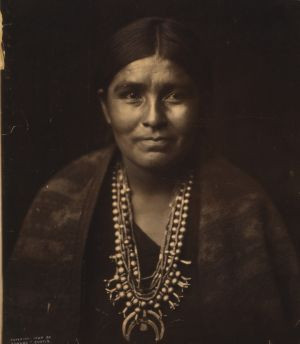 Navajo woman wearing a traditional squash blossom necklace
Navajo woman wearing a traditional squash blossom necklace
Upon returning home, my curiosity led to research, revealing a history of American Indian men wearing Squash Blossom necklaces. This exploration became the foundation for this reflection.
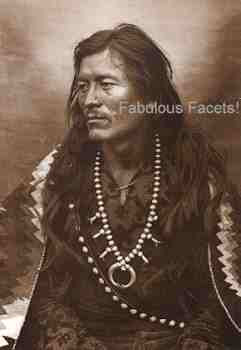 Variety of squash blossom necklaces
Variety of squash blossom necklaces
The Enduring Allure of the Squash Blossom Necklace
The Squash Blossom necklace stands as an iconic piece of Southwestern Native American jewelry for over a century. Its origins trace back to European influences of the 18th and 19th centuries. The Navajo people were the first to craft these necklaces, utilizing melted silver coins. Early designs featured simple silver chains with symmetrical “blossoms” and a crescent-shaped “Naja” at the center. While not all Squash Blossom necklaces include a Naja, most incorporate a central focal point.
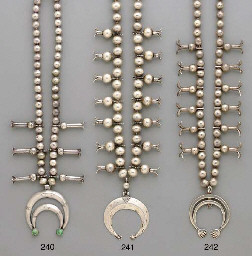 Three examples of squash blossom necklaces with varying designs
Three examples of squash blossom necklaces with varying designs
The name “squash blossom” remains somewhat enigmatic. The Navajo term for the necklace doesn’t directly translate to “squash blossom” in any Native language.
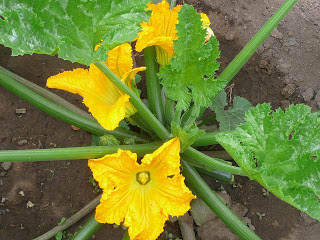 Close-up of a squash blossom necklace detail
Close-up of a squash blossom necklace detail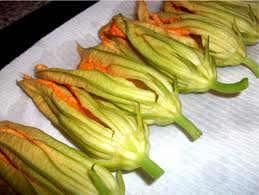 Close-up of a real squash blossom flower
Close-up of a real squash blossom flower
Linguistic interpretation might be the source of the name, perhaps a misinterpretation by early English or Spanish speakers. Visually, the necklace’s “blossoms” bear a limited resemblance to actual squash flowers. Nevertheless, the name has persisted, becoming deeply entwined with the jewelry’s identity and cultural landscape.
The Zuni tribe further evolved the design by incorporating gemstones, notably turquoise, set in fine silver bezels. Turquoise inlay has become a hallmark of many contemporary Squash Blossom necklaces.
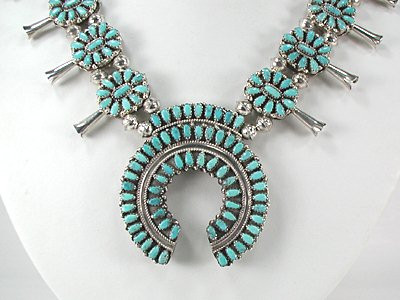 Zuni squash blossom necklace with turquoise and coral inlay
Zuni squash blossom necklace with turquoise and coral inlay
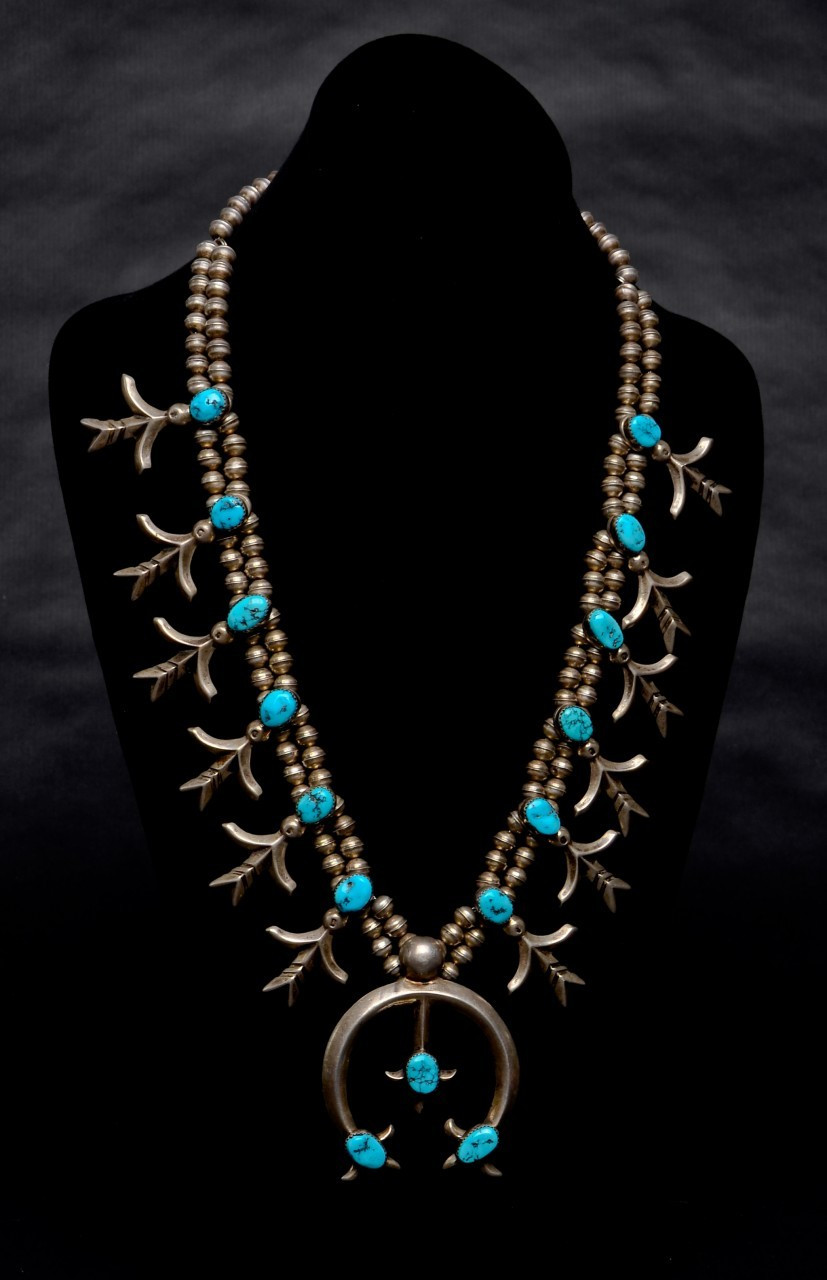 Navajo sand-cast squash blossom necklace
Navajo sand-cast squash blossom necklace
The antique Squash Blossom necklace I acquired for Tracy in Taos likely has a “dead pawn” history. Navajo individuals, often lacking access to conventional credit, historically relied on pawn shops, using family jewelry as collateral for loans. High interest rates sometimes led to forfeiture, with pawn brokers then selling these pieces as “dead pawn.” This system has contributed to the circulation of many older Navajo jewelry pieces.
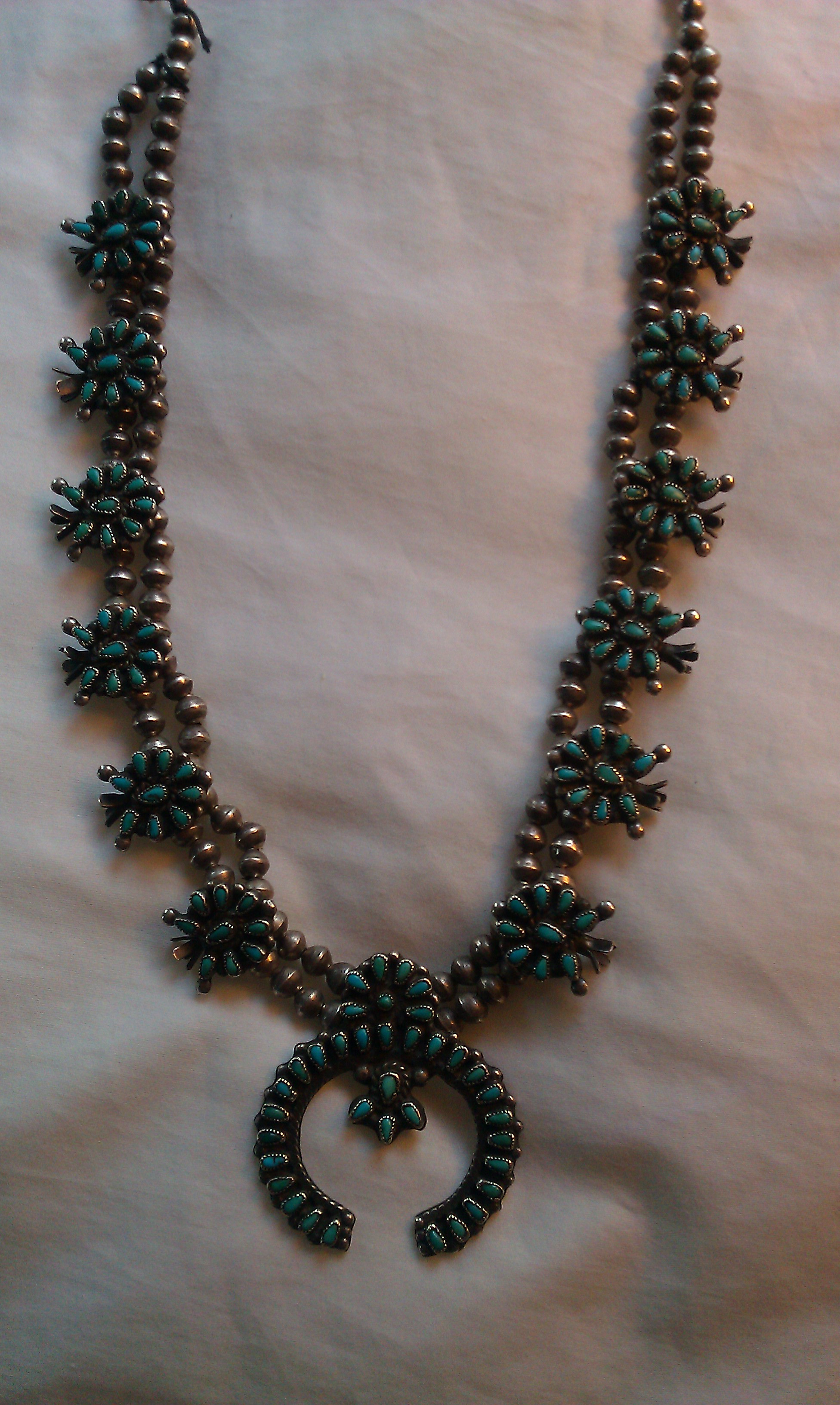 Tracy Hooper wearing her antique squash blossom necklace
Tracy Hooper wearing her antique squash blossom necklace
The Mystique of the Naja Pendant
Throughout history, diverse cultures have employed symbols to represent guiding forces. The inverted crescent is one such symbol. References to crescents as ornaments appear in the Bible and Phoenician culture, where it symbolized fertility. Ancient Roman and Cretan artifacts also feature similar motifs. [1]
During the Middle Ages, the Moorish influence in Spain introduced the inverted crescent as a bridal ornament. Muslim tradition associated it with protection for horse and rider against the “evil eye.” Spanish conquistadors then carried the symbol to the Americas, seeking similar protection for soldiers and horses. This historical diffusion suggests a transmission of the crescent symbol and related beliefs from Moorish to Spanish to Mexican to Navajo cultures. [2]
The Naja became integrated into Navajo horse tack, adorning the headstall. While some Navajo consider the Naja purely ornamental, lacking religious significance, the inverted crescent’s presence in Navajo art, including sandpaintings, weaving, and necklaces, is undeniable.
The Navajo also excelled in metallurgy.
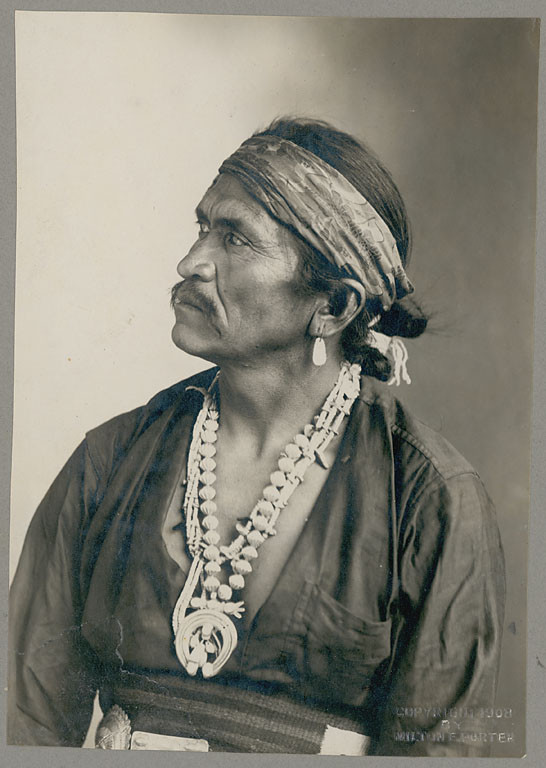 Chief Kia-E-Te-Nita wearing a squash blossom necklace and concha belt, 1908
Chief Kia-E-Te-Nita wearing a squash blossom necklace and concha belt, 1908
Navajo Silversmithing: An Artistic Legacy
The Navajo are renowned silversmiths, mastering the craft to an exceptional degree. Their artistry may be partly attributed to their use of Mexican silver, favored over German silver used by Plains Indians. [3]
German silver, despite its name, is an alloy of nickel, copper, and zinc, differing chemically from Sterling silver. Mexican silver, often 92.5% to 95% pure silver, is of higher quality. Sterling silver, standardized at 92.5% silver, is preferred for jewelry making due to its workability and durability compared to purer, softer silver. [4]
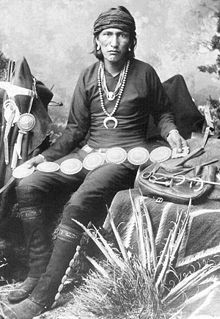 Atsidi Sani, a Navajo silversmith, circa 1883
Atsidi Sani, a Navajo silversmith, circa 1883
Silversmithing offered the Navajo a path from a nomadic warrior society to a more stable mercantile one. The prestige of craftsmanship brought wealth and influence, marking a significant cultural evolution.
Grandfather Tom Henio: Passing Down Silversmithing Traditions
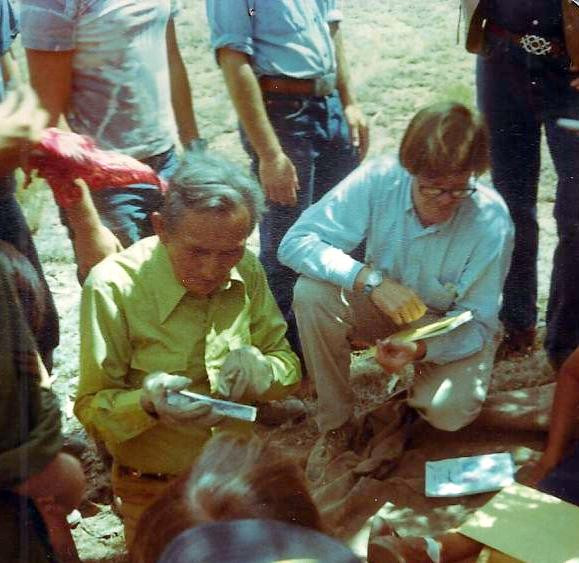 Tom Henio and Monty Billings preparing for a silversmithing lesson
Tom Henio and Monty Billings preparing for a silversmithing lesson
Grandfather Tom Henio, a respected Navajo artisan, builder, and jeweler, shared his sand-cast silversmithing skills with countless young people through the Cottonwood Gulch Foundation’s summer expeditions in New Mexico. The Foundation fostered creativity, and the Native American Workshop became a popular destination for campers eager to explore art.
I was fortunate to learn from Grandfather Henio and his daughter, Gracie. During his silversmithing lesson in the Gulch hogan, Gracie translated as he transformed sandstone and molten silver into art. We observed his meticulous etching of a Naja pendant mold into sandstone, creating air vents for silver flow. He clamped the mold, heated it, and poured molten silver into the cavity.
Despite the inherent risks of silversmithing, even when the stone cracked slightly, the casting was successful. After cooling and filing, Grandfather Tom meticulously polished the Naja. He later incorporated it into a Squash Blossom necklace, a special gift for his granddaughter’s Kinalda, a coming-of-age ceremony.
 John Mayer performing on stage
John Mayer performing on stage
Conclusion: Reconsidering Jewelry and Gender Norms
Thank you, John Mayer, for challenging perceptions by wearing a Squash Blossom necklace. My understanding of Navajo jewelry has been forever enriched. Your “Born & Raised” tour beautifully honored the Navajo Nation and the diverse Native American cultures of the Southwest.
Wishing you continued success on your world travels and future performances!
Postscript: Squash Blossom Necklaces and Modern Romance
 John Mayer and Katy Perry "Who You Love" artwork
John Mayer and Katy Perry "Who You Love" artwork
Reflecting on John Mayer’s relationship with Katy Perry during their song “Who You Love,” it’s interesting to note that in the music video, Katy Perry is depicted wearing a squash blossom necklace. Perhaps this beautiful jewelry transcends gender, fitting and meaningful for anyone who appreciates its artistry and symbolism.
References
[1] http://www.rivertradingpost.com/squashblossom.htm
[2] http://www.rivertradingpost.com/squashblossom.htm

